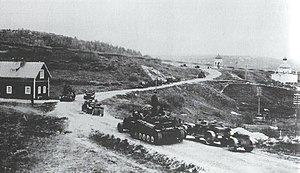Operation Silberfuchs
| Operation Silver Fox | |||||||
|---|---|---|---|---|---|---|---|
| Part of Continuation War and World War II | |||||||
 A German column during the advance on Murmansk, 1941 |
|||||||
|
|||||||
| Belligerents | |||||||
|
|
|
||||||
| Commanders and leaders | |||||||
|
|
|
||||||
| Strength | |||||||
| Casualties and losses | |||||||
| 21,501 Germans ~5,000 Finns |
Unknown | ||||||
|
|
|||||||
Operation Silver Fox (German: Silberfuchs) was a joint German–Finnish military operation offensive during World War II. Its main goal was to cut off and ultimately capture the key Soviet port at Murmansk through attacks from Finnish and Norwegian territory.
The operation had three stages. Operation Reindeer (Rentier) was the initial advance by German forces from Norway to secure the area around Petsamo and its valuable nickel mines. The follow-up operations, Operation Platinum Fox (Platinfuchs) from the north by Mountain Corps Norway and Operation Arctic Fox (Polarfuchs) from the south by XXXVI Mountain Corps together with units from the Finnish III Corps, aimed to cut off and capture the vital port of Murmansk afterwards in a pincer movement. Albeit the German-Finnish force was able to make some ground, Murmansk was neither cut off, nor taken, and continued to operate throughout the war.
Finland gained independence from Russia in the Finnish Civil War between German supported nationalists and Russian Bolshevik supported communists in the aftermath of World War I. Tensions between the new anti-communist republic and the newly established Soviet Union remained high during the early interwar years. Following a number of brief skirmishes between Finnish nationalists and the Soviet Union in Karelia, an agreement was reached regarding the border of the two countries. During the following years Soviet-Finnish relations remained stable, but still cool, and a 10-years non-aggression pact was signed in 1932.
...
Wikipedia

